
Spekesild (Norwegian for "salted herring") is Atlantic herring preserved using salt.

Spekesild (Norwegian for "salted herring") is Atlantic herring preserved using salt.
The preservation takes place by the salt extracting water from the herring, and thus poorer growth conditions are created for microbes. [1] Until the 1960s, herring was an important export item for Norway, but the decline in the herring fisheries led to these exports stagnating sharply. In the 1990s, exports picked up somewhat, and Russia, Sweden and Poland are important markets. [2]
The salted herring is soaked in freshwater for one and a half to two hours for desalination before eating.
In Norway, spekesild was for hundreds of years considered a poor man's diet that kept hunger away. A traditional Norwegian dish with salted herring (spekesild) is along with boiled potatoes, raw onions, dill, pickled beetroots, butter or crème fraîche and flatbrød. [3] [4]
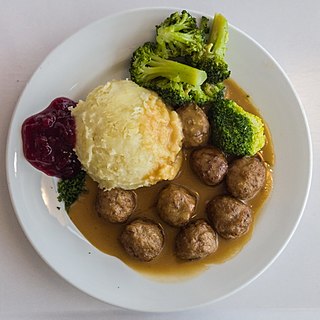
Swedish cuisine is the traditional food of Sweden. Due to Sweden's large north-to-south expanse, there are regional differences between the cuisine of North and South Sweden.
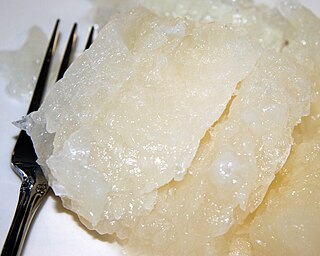
Lutefisk is dried whitefish, usually cod, but sometimes ling or burbot, cured in lye. It is made from aged stockfish, or dried and salted cod. The fish takes a gelatinous texture after being rehydrated for days prior to eating.

Roe, or hard roe, is the fully ripe internal egg masses in the ovaries, or the released external egg masses, of fish and certain marine animals such as shrimp, scallop, sea urchins and squid. As a seafood, roe is used both as a cooked ingredient in many dishes, and as a raw ingredient for delicacies such as caviar.
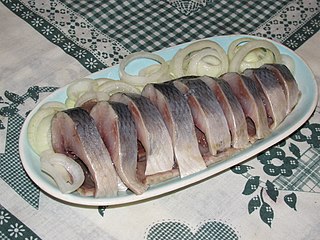
Pickled herring is a traditional way of preserving herring as food by pickling or curing.

Soused herring is raw herring soaked in a mild preserving liquid. It can be raw herring in a mild vinegar pickle or Dutch brined herring. As well as vinegar, the marinade might contain cider, wine or tea, sugar, herbs, spices, and chopped onion.
The Skåne Market or Scania market was a major fish market for herring which took place annually in Scania during the Middle Ages. From around 1200, it became one of the most important events for trade around the Baltic Sea and made Scania into a major distribution center for West-European goods bound for eastern Scandinavia. The Scania Market continued to be an important trade center for 250 years and was a cornerstone of the Hanseatic League's wealth.

Gravlax or graved salmon is a Nordic dish consisting of salmon that is cured using a mix of salt, sugar and dill. It is garnished with fresh dill or sprucetwigs and may occasionally be cold-smoked afterwards. Gravlax is usually served as an appetizer, sliced thinly and accompanied by hovmästarsås, dill and mustard sauce, either on bread or with boiled potatoes.

Smørrebrød, smørbrød "butter bread" (Norwegian), or smörgås "butter goose" (Swedish), is a traditional open-faced sandwich in the cuisines of Denmark, Norway and Sweden that usually consists of a piece of buttered rye bread, topped with commercial or homemade cold cuts, pieces of meat or fish, cheese or spreads, and garnishes.
Norwegian cuisine in its traditional form is based largely on the raw materials readily available in Norway and its mountains, wilderness, and coast. It differs in many respects from continental cuisine through the stronger focus on game and fish. Many of the traditional dishes are the result of using conserved materials, necessary because of the long winters.

Labskaus is a culinary speciality from northern Germany and in particular from the cities of Bremen, Hamburg, and Lübeck. The main ingredients are salted meat or corned beef, potatoes, and onion. Some recipes put beetroot, pickled gherkin, or even herring into it, while others have these ingredients as side dishes.

Flatbrød is a traditional Norwegian unleavened bread which is usually eaten with fish, salted meats and soups. Originally it was the staple food of Norwegian farmers, shepherds and peasants. Flat bread is dry and free from water so it is possible to store it for a long period of time.

Gibbing is the process of preparing salt herring, in which the gills and part of the gullet are removed from the fish, eliminating any bitter taste. The liver and pancreas are left in the fish during the salt-curing process because they release enzymes essential for flavor. The fish is then cured in a barrel with one part salt to 20 herring. Today many variations and local preferences exist in this process.
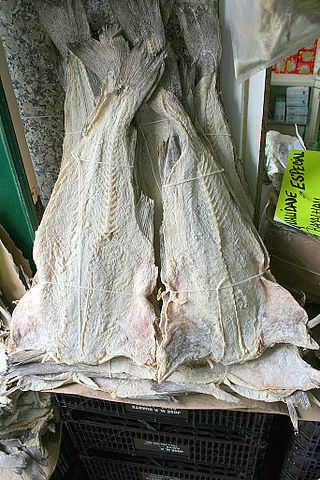
Dried and salted cod, sometimes referred to as salt cod or saltfish or salt dolly, is cod which has been preserved by drying after salting. Cod which has been dried without the addition of salt is stockfish. Salt cod was long a major export of the North Atlantic region, and has become an ingredient of many cuisines around the Atlantic and in the Mediterranean.
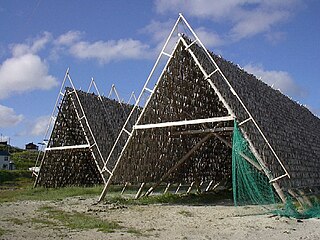
Boknafisk is a variant of stockfish and is unsalted fish partially dried by sun and wind on drying flakes ('hjell') or on a wall.

Surströmming is lightly salted, fermented Baltic Sea herring traditional to Swedish cuisine since at least the 16th century. It is distinct from fried or pickled herring.

Herring are forage fish in the wild, mostly belonging to the family Clupeidae. They are an important food for humans. Herring often move in large schools around fishing banks and near the coast. The most abundant and commercially important species belong to the genus Clupea, found particularly in shallow, temperate waters of the North Pacific and North Atlantic Oceans, including the Baltic Sea, as well as off the west coast of South America. Three species of Clupea are recognized; the main taxon, the Atlantic herring, accounts for over half the world's commercial capture of herrings.
The Herring Era Museum is located in Siglufjörður, Iceland. It is Iceland's largest maritime museum and the only Icelandic museum to have won the European Museum Award. The museum officially opened in 1994 in Róaldsbrakki, an old salting station which had been left abandoned after the collapse of the herring stock in 1969. Additionally two more buildings have been built for the museums exhibitions since then. Also, the museum owns the Old Slipway down by the harbour. Siglufjörður used to be the center of the herring fisheries in Iceland, and the herring played a very large role in the nations economy and industry, providing as much as 44% of the nations export income during some years. As of 2023, ticket prices for adults are 2.200 ISK; seniors and youth 1.200 ISK; children free, accompanied by adults; groups 1.800 ISK.

Herring salad is a mixed salad consisting of cut and salted herring, beetroot, potato, onion, mayonnaise and whipped cream.